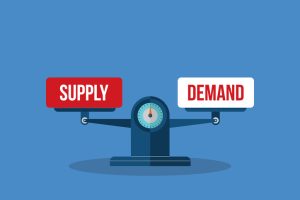Using Business Intelligence to Match Supply and Demand
 In order to run a lean and agile supply chain, manufacturers need to have a clear understanding of the supply and demand curves in their given market. After all, if demand is underestimated there may not be enough inventory to cover orders, which could translate into strained (or lost!) customer relationships. And on the flip side, if demand is overestimated, warehouses filled to the brim with product could translate into major overhead and cash flow issues. In both situations supply and demand curves need to be optimized.
In order to run a lean and agile supply chain, manufacturers need to have a clear understanding of the supply and demand curves in their given market. After all, if demand is underestimated there may not be enough inventory to cover orders, which could translate into strained (or lost!) customer relationships. And on the flip side, if demand is overestimated, warehouses filled to the brim with product could translate into major overhead and cash flow issues. In both situations supply and demand curves need to be optimized.
With business intelligence software manufacturers can better predict trends to show supply and demand curves based on seasonal demand, promotions, slow-moving items, causal variables, outliers, and much more.
Demand Forecasting
Industry analysts estimate that collaboration among supplier and vendors can improve the accuracy of plans and forecasts by as much as 30%, resulting in less variability across the supply chain, lower inventories and improved customer satisfaction. After all, the supply chain is influenced by 101 things. Should demand for one product go up, then various points in that product’s supply chain need to increase in production as well. Plus, it all needs to be accomplished before the real demand hits and consumers are looking to buy.
Predictive business intelligence applications can be used to produce accurate, statistics-based demand forecasts that leverage current, historical and external information like point-of-sale from a single, enterprise-wide data repository. Plus, these plans or forecasts can be published on the web so that other people can view them and suggest changes based on real-time information related to supply and demand variances.
Demand Management
Business intelligence solutions can also be used to manage demand through the use of pricing what-if scenarios to better understand the impact of forecasted demand on sales revenue. Event schedules can be added to the mix to better assess the potential impact of promotions, calendar events and other activities on demand projections. Plus, the analytics and reports available via BI solutions can be used to track and analyze forecasts in order to better understand and improve demand planning accuracy.
Supply Planning
On the supply side, BI software can provide a better understanding about how the Sales and Operations Plan will be covered in terms of supply. This is accomplished by pulling all sales plans, demand forecasts, open orders, shipments, production plans and inventory into a single repository and using analytics and alerts to gain the visibility needed to determine the supply required to meet both projected and actual demand. This 360-degree view of the supply chain gives manufacturers the ability to ramp up or ramp down production in a timely manner, minimizing wasted resources and maximizing revenue.
Thanks to business intelligence software, these are just a few of the ways in which manufacturers can better ensure their supply is in line with demand.